This page represents the genesis of the project in terms of our NSF grant proposal. Some of the methods and results have changed since then; see our publications page for more
(Alternatively, the original project details can be accessed here as a .pdf file.)
Overview
The objective of this project is to understand the meanings and grammatical contribution of verbal roots, the portion of a verb’s meaning that uniquely distinguishes it from other, grammatically similar verbs, addressing two specific questions: (i) what are possible and impossible root meanings, and (ii) how are root meanings integrated into the larger meaning of the verb? Although of long-standing interest, (i) is vastly underexplored, and both have been largely unexamined within the modern tradition of formal semantics (e.g. Montague 1973 and Dowty 1979). Through a careful examination of the syntax and semantics of two case studies—change-of-state verbs and ditransitives of caused possession, investigated through grammar and dictionary work plus primary fieldwork — this study will bring answers to these questions to bear on modern theories of verb meaning, and lead to a better understanding of roots and their impact on morphosyntax.
Background and Research Context
One of the core questions in the study of verbal meaning is what the fundamental building blocks of a verb’s meaning are and how they are composed into more complex meanings. One clue that has tantalized researchers since at least Lakoff (1965) is that verbal meanings are often roughly (if not precisely) paraphrasable by analytic constructions that make plain certain basic subcomponents of their meaning. For example, the use of transitive flatten in (1a) is subject to the near paraphrase in (1b), which highlights the structure of the event it describes as an action that caused a change.

Intransitive flatten in (2a) instead has the near paraphrase (2b), which constitutes a portion of (1b):

Other verbs are subject to nearly identical paraphrases, differing only in what the final state is:

Conversely, paraphrases of jog and run emphasize just action, differing only in which action:
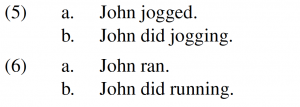
Crucially, the paraphrases highlight the kinds of events that each verb describes, and decompose them into more basic subevents. These include frequent and recurring fundamental notions such as “action”, “cause”, and “become” that differentiate whole classes of verbs and more specific notions like “flat”, “dry”, “jogging”, and “running” that differentiate verbs within these classes.
Based on observations like these, many researchers now assume that verb meanings are at least partly constrained by some level of semantic representation known as an “event structure” that categorizes and defines the eventuality described by the verb (Dowty 1979, Pinker 1989, Jackendoff 1990, Levin and Rappaport Hovav 1995, 1998, Wunderlich 1997, Van Valin and LaPolla 1997, Rappaport Hovav and Levin 1998, inter alia). Event structures are assumed to consist of two ontologically distinct types of lexical semantic entities. First is a generic “event template”, built up from a small, universal set of logical primitives (e.g. CAUSE, BECOME, GO), that captures the basic temporal, causal, and thematic nature of the event described by the verb (in the spirit of Dowty 1979) and groups verbs together into a small set of broad semantic classes. These include caused and simple changes-of-state as in (1)-(4), plus actions such as those in (5) and (6). The second component of an event structure is an idiosyncratic “root” that fills in the additional details of the event structure, e.g. specific actions or states involved in a given event, on a verb by verb basis. Thus the two uses of flatten differ in whether the change-of-state was simple or caused, but share an idiosyncratic root that names the result in both cases as a state of flatness. Jog instead has a template encoding a simple action, with the root indicating the nature of the action. The resultant event structural representations are illustrated in (7) (following Rappaport Hovav and Levin’s 1998 notation). Similar event structures for intransitive and transitive dry and intransitive run are given in (8), which share the same templates as in (7), but differ in the roots.

A further common assumption is that only templatic information figures into grammatical generalizations. For example, argument realization rules are generally taken to only be sensitive to this portion of the event structures in (7)-(8) (see also Fillmore 1970, Grimshaw 1993). Thus while transitive flatten and dry differ in idiosyncratic meaning, they both pattern syntactically as causative verbs. Jog and run both pattern as unergatives, and thus have an intransitive syntax distinct from unaccusatives like intransitive flatten and dry. This assumption furthermore (correctly) predicts that there are far fewer grammatical classes of verbs than specific verbs. Indeed, a significant strand of work takes the correlation between templatic meaning and grammatical behavior to be so strong that event templates must be entailed directly in the syntax via functional heads (e.g. light verbs of category v) whose meanings indicate basic eventive notions (e.g. vCAUSE, vBECOME, and vACT; Folli and Harley 2004) and whose projections define a constituent structure representing the event template (Lakoff 1965, Hale and Keyser 1987, 1993, 1997, Pesetsky 1995, Baker 1997, Marantz 1997, Hale and Keyser 2002, Folli and Ramchand 2002, Folli and Harley 2004, Harley 2003, Arad 2005, Ramchand 2008, inter alia). Idiosyncratic meanings are contributed by purely lexical (and often category-less) morphological roots integrated into the larger template in different ways. Theories differ on the details, but two common assumptions are that roots serve as either syntactic adjuncts (if indicating a type of action) or complements (if indicating a state) to appropriate functional heads. The event structures in (7) can thus be reanalyzed as in (9) (similarly for (8)).
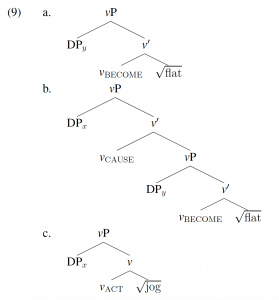
Regardless of implementation, all event structural approaches share the core assumption that a distinction exists between two types of subcomponents to a verb’s meaning—the templatic structure and the idiosyncratic root—and this distinction figures into the verb’s grammatical behavior. Here and below a syntactic implementation of event structures is assumed for concreteness.
While much work in decompositional approaches has focused on the semantic and syntactic ramifications of templatic heads, less work has been devoted directly to roots, and in particular to what truth conditional semantic constraints—if any—exist on them. The questions include what constitute possible and impossible roots, how roots are distinct from templatic heads in terms of the content they may entail, and what their combinatoric properties are that integrate their meanings with those of the templates they occur in. Such questions are, in fact, key to understanding what predictions any theory of event structure makes about grammatical behavior. As Dowty (1979: 125-129) discusses, many of the supposed predictions made by event structural approaches regarding possible and impossible verb meanings may be questionable without a predictive theory of possible root meanings. Work that has focused on root meanings has generally been less concerned with the truth conditional content of roots and more in where they fit into event templates, something that has some truth conditional correlation but is largely a syntactic question. Levinson (2007) for example argues for four different type-theoretic classes of roots (building on Harley 2005): those denoting predicates of individuals, predicates of states, predicates of events, and functions from individuals to predicates of states, which has ramifications for which event structures different roots fit into. Rappaport Hovav and Levin (1998) discuss a somewhat more fine-grained classification of roots into more concrete types (including instruments, places, states, and events) and propose a series of canonical realization rules for the templates they occur in. Ramchand (2008) assumes all roots predicate of either states or events, but further classifies roots in terms of which functional templatic heads they must merge with and thus ultimately what kinds of event templates they may occur in. However, none of these works discusses the subtypes of events, states, and individuals that may exist among these types and what kinds of truth conditional content they bring to the overall event structure. Kelly (2013) partly addresses this, arguing that roots are associated with features borrowed from Hopper and Thompson (1980) and Dowty (1991) that are not compositional in nature but figure into principles of building event structures that predict certain syntactic facts about argument alternations (see Megerdoomian 2002 and Alexiadou et al. 2006 for proposals in some ways similar in spirit to Kelly’s). However, these features are treated as syntactico-semantic, with few details of the truth conditional content of specific roots.
This project therefore proposes to explore the truth conditional basis for root meanings and their relation to templatic meaning in detail. More specifically, it addresses two primary questions:
(i) What are the semantic underpinnings of the distinction between roots and templates, if any? Are there particular kinds of meanings that only templates or roots introduce?
(ii) How do root and template meanings compose with one another? If they introduce overlapping meanings, how is this overlap resolved?
Question (i) is whether an ontological distinction between templates and root — between what is regular in a verb’s meaning and what is idiosyncratic—is justified.While it is uncontroversial that meanings like “cause” and “become” can be introduced templatically, can they only be introduced templatically? The exploration of (i) proposed here starts with the hypothesis, articulated most clearly by Embick (2009: 1) but implicit or explicit in much recent work (e.g. the “Root Hypothesis” of Arad 2005; see also Borer 2005, 2013, Dunbar and Wellwood 2016), that root and template meaning are distinct:

Testing (10) requires an understanding of the syntactic and semantic behavior of relevant verbs and direct evidence for where particular components of their meanings come from. Initial pilot studies, in particular Beavers and Koontz-Garboden (2012) (see also Koontz-Garboden 2010b, 2011, Beavers 2011a,c, 2013), suggest that the roots of certain verb classes violate (10). However, further investigation is needed to solidify these conclusions and their consequences for the nature of root meaning more generally. The goal of this project is to perform a detailed investigation of the semantics and grammatical behavior of two verb classes identified in prior work to be relevant to this question—change-of-state and ditransitive verbs —to support these initial findings.
These results will feed into the investigation of (ii), a question that is underexplored yet very important for theories of event structures. Unless the meanings of the individual components of the event structure, and the rules for composing them, are made explicit, it is unclear that any claimed predictions of the theory actually hold. This issue arises particularly sharply if the meanings entailed by root and template are not distinct, something already suggested in Beavers and Koontz-Garboden (2012). The goal is to develop an explicit, model theoretic, truth conditional theory of the relevant root and template meanings that makes clear how semantic composition in event structures proceeds. The core idea is that roots and templates are alike in encoding truth conditional content regarding events and their participants à la Dowty (1991) and Beavers (2010). They differ only in their specificity: templatic functional heads have content that is of a highly general nature, while roots have content that is more specific and idiosyncratic. However, the more specific lexical entailments that roots entail may asymmetrically entail the more general lexical entailments entailed by functional heads, thus deriving that the root also entail these templatic meanings. With the relevant root and template-introduced meanings in any given event structure composed conjunctively (building on Pylkkänen 2008), such entailment relationships result in a subsumption relation between root and template meanings in some cases and in other cases an augmentation relation where each adds to the other’s meaning, all in ways that generate compositionally well-formed meanings of complete event structures.
Research Methods
This section outlines the two major case studies proposed in this project.
Change-of-state verbs — Background
A standard analysis of change-of-state verbs is that the root and template introduce distinct meanings per the Bifurcation Thesis. There are four relevant templates: (in)transitive verbs (11a,b) and simple and deverbal predicate adjectives (11c,d).
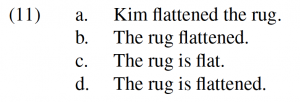
As discussed above, in the event structure of (11a) the result comes from the root and the caused change from the template, as in (12a), and similarly for (11b), which has the same event structure as (11a) minus the causation, as in (12b). That the meaning of change comes from the template and not the root is evidenced by the fact that the same morphological root occurs in other constructions such as (11c), with the corresponding template in (12c) (Asp being the adjectivalizing head, following Embick 2004, 2009), but with no caused change entailed. Thus the meaning of causation and change cannot come from the root and must therefore come from the template in which it occurs. Conversely, the root morphological form also surfaces as a deverbal adjective in (11d), where caused change is entailed. This suggests an analysis of the event structure of (11d) in which the event structure in (12a) (or alternatively (12b)) is embedded in that of (12c), producing something like (12d), explaining both the entailment patterns and the deverbal morphology.
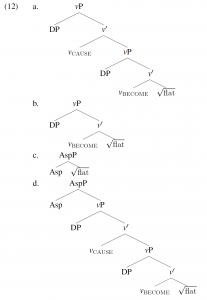
In all cases, the root just names a state, and thus should occur in all four templates. Morphologically, the Bifurcation Thesis predicts that the simple and deverbal adjectives and corresponding (in)transitive change-of-state verbs constructed from state-denoting roots should by default be identical in their morphological structure. This is because the functional elements that compose with roots to form adjectives and (in)transitive change-of-state verbs are shared across all adjectives and change-of-state verbs. Since combinations of these functional elements determine morphological structure, each surface word should be identical save the root. Exceptions should be due only to idiosyncratic variation in surface morphological realization on a root-by-root basis.
However, a comparison of two classes of change-of-state verbs and their corresponding adjectives show systematic subregularity not predicated by the Bifurcation Thesis. In particular, while the pattern in (11) is attested for verbs based on Dixon’s (1982) “Property Concept” roots in (13), there are change-of-state verbs for which it is not, including those in the break class in (14).

For example, transitive and intransitive break also entail caused change-of-state, as in (15a,b), but lacks a simple adjectival form, as in (15c), having only a deverbal form, as in (15d).
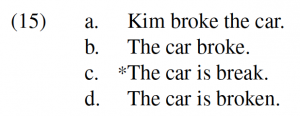
Embick (2004) treats (15c) as representing both the simple and deverbal adjectival predicates, where it is an accident of English that flat and other property concept roots have morphologically distinct stative forms while break and other verbs have only one. On this view, Asp is idiosyncratically null in direct merger with some roots (property concept roots) and not others (those in the break class). However, pilot data suggest, contrary to this view, that this state of affairs is not accidental (see Koontz-Garboden 2010b, 2011, Beavers and Koontz-Garboden 2012) . Translations of verbs that pattern as in (15) in English also consistently pattern this way in other languages, such as Eastern Armenian (Megerdoomian 2002) and Ulwa (Koontz-Garboden 2006, 2009), as shown by the following data (see also Smith 2006 on Pima):
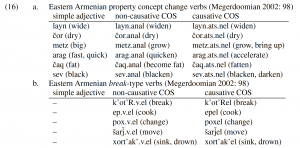
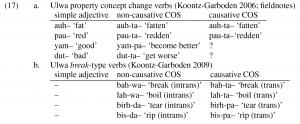
These facts suggest that there is regularity across languages in how roots with certain meanings behave, and thus the patterns in (11) and (15) cannot be due to pure idiosyncrasy. Furthermore, on the semantic side, (15d) lacks the simple state reading Embick’s analysis predicts: (15d) always entails prior change (#The car is broken, but it never broke) (even when atemporal; Koontz-Garboden 2010a, Deo et al. 2013), whereas the simple form of flat does not (The car is flat, but it was never flattened). These data again suggest that the roots of change-of-state verbs are not semantically homogeneous. Rather, some classes inherently and consistently require a prior change giving rise to the state (break) while others do not (flat), i.e. there are entailments of change that are entailed by the roots themselves (as opposed to in functional heads), contra the Bifurcation Thesis. This in turn has regular morphological ramifications, an effect normally thought to be reserved for templates, supposedly the only grammatically significant part of a verb’s event structure.
Change-of-state verbs — Scope of work
These results are currently tentative. The goal of this project is to verify them cross-linguistically by systematic grammar and dictionary mining and fieldwork (based on the methodologies of Nedyalkov and Silnitsky 1973, Haspelmath 1993, Nichols et al. 2004). Morphologically, the project looks across a sample of languages to see if translation equivalents of the property concept and break classes behave as expected given the pilot observations. The first step is to formulate a list of change-of-state verbs and adjectival counterparts, building on previous work in Koontz- Garboden (2011), and then examine the morphological behavior of their translational equivalents in a set of languages with good lexical and grammatical resources. The data examined is drawn largely from the languages in the World Atlas of Language Structures 100-language sample (Comrie et al. 2013), an ideal set of languages developed to be genealogically balanced and for a majority of which published descriptive resources exist. Owing to lack of appropriate resources, some languages were not usable for this project and were either dropped or substituted with languages from the larger WALS 200 language sample, and a few languages were added opportunistically if we had available language experts to consult. The final total is a balanced 87 language sample. The relevant roots are given in (18) and (19) (as an adjective or verb, with synonyms or hypernyms considered in that study given in parentheses).
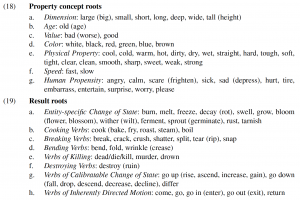
The data collected for each root meaning in each language includes (a) translation equivalents of simple state (e.g. red), inchoative (e.g. intransitive redden), causative (e.g. transitive redden), and result state (e.g. reddened), plus any underlying bound roots of those forms for any languages that have those, (b) information about the morphological relationships that relates those terms (drawn on and expanding Haspelmath 1993), including whether it is derived from, the input to, labile, suppletive, or equipollent with any other root, (c) a bibliographic reference for each form, and (d) free form notes on relevant details of the overall paradigm for that root meaning in that language (such as the nature of the morphological relation between forms, idiosyncrasies in the data, or noteworthy additional relevant properties). The primary goal is to test whether property concept roots tend to have simple stative terms while result roots do not across languages, as well as looking for other systematic correlates of the property concept vs. result root distinction.
This sort of broad typological work is important in establishing the generalization. However, it is also important to test whether the morphological evidence correlates with the semantic entailment patterns predicted based on the preliminary observations from English. This requires primary fieldwork, and thus cannot be conducted on a large scale. The second step in the project is to investigate the question in one language unrelated to English — the Bantu language Kinyarwanda, for which work on applicatives, described below, is independently required by the project. Bantu is an ideal choice since there already exists a rich syntactic and morphological literature on deverbal stative predicates which can be taken as a point of departure (see e.g. Dubinsky and Simango 1996). The data collection will involve using diagnostics developed in Koontz-Garboden (2010a), Beavers (2011b), and Beavers and Koontz-Garboden (2012) to identify entailments of change in the roots of translational equivalents of the verbs used in investigating the morphological patterns described above.
Third and finally, a general, model-theoretic formal analysis will be developed for the relevant roots and templatic formatives, addressing how roots can contribute templatic meaning in a context of templatic elements which entail the same meanings, e.g. how both a root and a template can entail a notion of change at the same time, a non-trivial problem. The current core intuition, based on preliminary work in Koontz-Garboden (2006) and Beavers and Koontz-Garboden (2012), is that some state-denoting roots entail the existence of a cause for the state and may place conditions on possible causes. These conditions constrain how the change entailed by the template is interpreted in ways that effectively integrate their meanings (building on ideas from Marantz 2009). The work will also identify subclasses of roots of change-of-state verbs that underlie the patterns seen above.
Ditransitive verbs —Background
A standard analysis of ditransitives is that they are associated with one or both of two event templates, which Harley (2003) analyzes as vCAUSE combining with a dyadic head representing either possession or co-location, as in (20). These underlie the indirect object (IO) and to PP frames for ditransitives, with verbs occurring in both showing the “dative alternation”. In both cases, the root modifies (adjunctively) the vCAUSE head to indicate the manner of the causation.
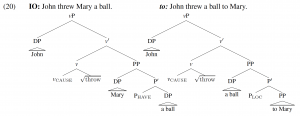
This analysis predicts several grammatical facts about ditransitives, including argument realization facts such as the dative alternation, asymmetric c-command facts between the two non-agent coarguments that arise in each variant (Barss and Lasnik 1986, Larson 1988), and the behavior of scopal modifiers with ditransitives (as per Beck and Johnson 2004). It also makes correlating semantic predictions about the two variants, most pertinently that IOs, but not to-marked DPs, must be capable of possession, giving rise to the fact that an inanimate IO must be interpreted as animate (i.e. able to possess, the “London Office” effect of John threw the ball to London/#threw London the ball; cp. (20); Oehrle 1976). Crucially, in both cases the result state entailed in each event structure comes not from the root as with canonical change-of-state verbs, but instead from the template itself, in terms of the functional heads Phave and Ploc. Thus the assumption that would follow if the Bifurcation Thesis holds is that these semantic notions cannot be introduced by roots.
However, work by Rappaport Hovav and Levin (2008) and Beavers (2011a) (building on Green 1974, Pinker 1989; see also Beavers 2011c, 2013, Beavers and Koontz-Garboden 2012) shows that there is considerably more root-specific variation in what each variant means than this predicts. First, to variants sometimes do not entail motion at all, but do entail possession, as with verbs of giving (e.g. give, hand, pass (the salt)) and future having (e.g. bequeath, leave, will), giving rise to the “London Office” effect even in to variants:
![]()
Thus the meaning of the Ploc head must not be arrival per se, but something more general that subsumes both arrival and possession. This correlates with a second fact about the classes of giving and future having verbs in (21): unlike all other ditransitives, they show no truth conditional contrast in the dative alternation, always encoding caused possession.
Third, although the typical results for (20) are possession or arrival, for many verbs these results states are in fact cancelable, as with future having verbs as in (22a) and sending/ballistic motion verbs (e.g. send, throw, toss) as in (22b). This is especially surprising since these predicates are nonetheless telic (Jackendoff 1996, Krifka 2004, Beavers 2011a):
![]()
Rather, possession or arrival is merely prospective (Gropen et al. 1989, Beavers 2011a). However, cancelability does not obtain for giving verbs as in (23a) and accompanied motion verbs (e.g. carry, take, bring) as in (23b), which require actual possession and actual arrival respectively, though in the latter case possession is cancelable in the IO frame, as in (23c).

In sum, the result states entailed by the two templates in (20) are cancelable and thus need not necessarily obtain (though they may), and furthermore the meaning of the Ploc is weaker than arrival, subsuming also possession. Whether the reading is arrival or possession (or both), and whether the result obtains or not, is contingent on the choice of the lexical root. The root thus does more than just name a causing action. It also determines which result is entailed, whether it occurs, and aspectual properties of the predicate, suggesting again that roots entail templatic meaning, contra the Bifurcation Thesis. (See also Beavers and Nishida 2010 for similar results on Spanish.)
The effect of the root on the meaning of the templatic elements can be seen more visibly in languages in which templates have overt morphological exponence. In Bantu languages such as Kinyarwanda, English IOs often translate as applicative objects (AOs), which occur with verbs bearing an applicative morpheme. A standard analysis is that the applicative monotonically adds new templatic meaning to the verb, contingent solely on the choice of applicative (see e.g. Pylkkänen 2008). For example, the interpretation with most transitive verbs of the AO introduced by the applicative morpheme –ir/er– is benefactive, as with Kinyarwanda kumena ‘break’ in (24).

However, pilot data suggest that the AO’s interpretation is also partly contingent on the verbal root. Lexical ditransitives may license different meanings for their AOs despite identical applicative morphology. For example, with koherera ‘send’, which inherently involves three participants, the AO is either a benefactive or a (non-benefactive) recipient as in (25). (In this case the AO realizes a participant already lexically selected by the base verb, a seldom noted function of applicatives; see Marten and Kempson 2002 and Marten 2003.) A pure recipient reading is ruled out for the AO in (24b), which must benefit from the event but need not necessarily receive the theme.

Furthermore, some verbs, such as guha ‘give’ in (26a), take putative AOs without a corresponding applicative morpheme (Polinsky and Kozinsky 1992), suggesting different verb-specific constructions encoding the same templatic meaning, reminiscent of the morphological differences across change-of-state verbs. If an applicative marker is used, it creates a tritransitive with the newly introduced AO being a benefactive, as in (26b) (where the overt DP is the recipient and the 1st singular benefactive is realized as object-marking on the verb).

However, other such verbs behave differently. The lexical double object verb gutera ‘throw (at)’ also allows applicative marking, but in this case a recipient reading is possible:

Thus applicatives do not always just monotonically contribute additional templatic meaning to that already entailed in the base verb. Rather, they seem to have more general, underspecified meanings which the root can in some cases fill in with specific templatic details. Thus there is again more templatic meaning entailed by roots than expected by the Bifurcation Thesis.
Ditransitive verbs —Scope of work
These data are only suggestive. This project proposes a study to see if this hypothesis is borne out. This requires detailed investigation of the behavior of applicatives across different ditransitive verb classes in a language with productive applicatives, like Kinyarwanda, an ideal case study as there is already literature on its applicative morphology (Gary and Keenan 1976, Kimenyi 1980, Dryer 1983, Gerdts andWhaley 1991, Polinsky and Kozinsky 1992, Zeller and Ngoboka 2014, inter alia). The first step is to develop a list of ditransitives from relevant subclasses drawn from classifications in Pinker (1989), Croft et al. (2001), Rappaport Hovav and Levin (2008), and Beavers (2011a). The following roots were those deemed relevant:
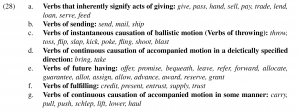
Seemingly relevant translations of some of these roots into Kinyarwanda are the following:
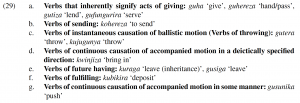
Fieldwork will then be conducted, investigating the event structural properties of applicativized and non-applicativized variants of the chosen ditransitives, following standard diagnostics and methodologies discussed in prior literature. These include syntactic and semantic diagnostics to probe the shape of event templates in ditransitives in other languages, including (a)symmetric c-command facts (Larson 1988, Harley 2003), the behavior with scopal modifiers (Beck and Johnson 2004), the interaction of the applicative morpheme with other event structural morphology (Pylkkänen 2008), and lexical aspectual properties (Beavers 2011a), among others, to assess the broader templatic effects of applicativization. Careful attention will be paid to verb-specific event structural effects such as those seen above for English, particularly the effects of different verbal roots on the interpretation of an applicative structure, including entailments of actual and prospective result states, the contexts that determine the use of each variant, and the semantic relationship of the applicativized and non-applicativized pair, e.g. entailment relations, London Office-type effects, etc. (Green 1974, Pinker 1989, Rappaport Hovav and Levin 2008, Beavers 2010, 2011a). Similar properties for the same applicative morphemes with non-ditransitive verbs — in particular change-of-state verbs — will also be examined to serve as control cases. The goal will be (i) establishing the overall semantic contribution of the applicative itself, (ii) the meanings of the roots that occur with this kind of applicativization, and (iii) the significant interaction of the two as per above.
As with change-of-state verbs, a formal model-theoretic analysis will be developed to accommodate the patterns and identify the semantic basis for the behaviors seen above. The core intuition (building on Beavers 2011a and Beavers and Koontz-Garboden 2012) is that the roots of ditransitive are manner roots (as per Harley 2003) but also entail a result and place constraints on the possible results. These constraints will determine the interpretation of the result introduced by the template in a way that integrates their meanings. The resulting work will also identify any potential subclasses of ditransitive roots that underlie patterns akin to those seen above.
Summary
If the preliminary results are borne out, this work will demonstrate that root and template meaning are not bifurcated. Such a finding feeds directly into the development of a theory of the lexicons of natural languages, anticipated and briefly sketched out in Beavers and Koontz-Garboden (2012), in which event structures still figure into how verb meanings are constructed, but the contributions of different pieces are more complex than previously assumed, and templatic meaning arises from multiple sources. Furthermore, it suggests a typology of roots by which the roots of various verb classes are not homogeneous (contra general assumptions in the literature), but instead fall into systematic subclasses based on what kinds of and how much grammatically-significant templatic meaning they also entail. These include the multiple types of change-of-state and ditransitive roots investigated here. The formal analyses will clarify the kinds of contributions that roots can make to event templates and help develop an understanding of the ways roots and templates interact in forming a larger event structural meaning.
References
Alexiadou, Artemis, Elena Anagnostopoulou, and Florian Sch¨afer. 2006. The properties of anticausatives crosslinguistically. In Phases of interpretation, ed. Mara Frascarelli, 187–211. Berlin: Mouton de Gruyter.
Arad, Maya. 2005. Roots and patterns: Hebrew morpho-syntax. Dordrecht: Springer.
Baker, Mark C. 1997. Thematic roles and syntactic structure. In Elements of grammar, ed. Liliane Haegeman, 73–137. Dordrecht: Kluwer.
Barss, Andrew, and Howard Lasnik. 1986. A note on anaphora and double objects. Linguistic Inquiry 17:347–354.
Beavers, John. 2010. The structure of lexical meaning: Why semantics really matters. Language 86:821–864.
Beavers, John. 2011a. An aspectual analysis of ditransitive verbs of caused possession in English. Journal of Semantics 28:1–54.
Beavers, John. 2011b. On affectedness. Natural Language and Linguistic Theory 29:335–370.
Beavers, John. 2011c. Roots, argument structures, and leixcal entailments. Talk given at Structuring the Arguments, September 5-7, Universit´e Paris 8 – Centre national de la recherche scientifique 8, Paris, France.
Beavers, John. 2013. The interaction of roots and templates in verbal meaning. Talk given at the 5th International Conference on the Linguistics of Contemporary English, September 25-29, The University of Texas at Austin, Austin, TX.
Beavers, John, and Andrew Koontz-Garboden. 2012. Manner and result in the roots of verbal meaning. Linguistic Inquiry 43:331–369.
Beavers, John, and Chiyo Nishida. 2010. The Spanish dative alternation revisited. In Romance linguistics 2009: Selected papers from the 39th linguistic symposium of romance languages, 217–230. Amsterdam: John Benjamins.
Beck, Sigrid, and Kyle Johnson. 2004. Double objects again. Linguistic Inquiry 35:97–124.
Borer, Hagit. 2005. Structuring sense, vol. I and II. Oxford: Oxford University Press.
Borer, Hagit. 2013. Structuring sense, vol. III. Oxford: Oxford University Press.
Comrie, Bernard, Matthew S. Dryer, David Gil, and Martin Haspelmath. 2013. Introduction. In The world atlas of language structures online, ed. Matthew S. Dryer and Martin Haspelmath. Leipzig: Max Planck Institute for Evolutionary Anthropology. http://wals.info/chapter/s1.
Croft, William, Jóhanna Bardal, William Hollmann, Maike Nielsen, Violeta Sotirova, and Chiaki
Taoka. 2001. Discriminating verb meanings: The case of transfer verbs. Handout, LAGB Autumn Meeting, Reading.
Deo, Ashwini, Itamar Francez, and Andrew Koontz-Garboden. 2013. From change to value difference in degree achievements. In Proceedings of Semantics and Linguistic Theory 23, 97–115. Ithaca, NY: CLC Publications.
Dixon, R.M.W. 1982. Where have all the adjectives gone?: And other essays in semantics and syntax. The Hague: Mouton.
Dowty, David. 1979. Word meaning and Montague grammar. Dordrecht: D. Reidel Publishing.
Dowty, David. 1991. Thematic proto-roles and argument selection. Language 67:547–619.
Dryer, Matthew S. 1983. Indirect objects in Kinyarwanda revisited. In Studies in relational grammar 1, ed. David M. Perlmutter. Chicago, IL: University of Chicago Press.
Dubinsky, Stanley, and Silvester Ron Simango. 1996. Passive and stative in Chichewˆ a: Evidence for modular distinctions in grammar. Language 72:749–781.
Dunbar, Ewan, and Alexis Wellwood. 2016. Addressing the “two interface” problem: Comparatives and superlatives. Glossa 1:1–29.
Embick, David. 2004. On the structure of resultative participles in English. Linguistic Inquiry 35:355–392.
Embick, David. 2009. Roots, states, and stative passives. Talk given that the 2009 Roots Workshop, Stuttgart.
Fillmore, Charles. 1970. The grammar of hitting and breaking. In Readings in English transformational grammar, ed. Roderick Jacobs and Peter Rosenbaum. Waltham, MA: Ginn.
Folli, Raffaella, and Heidi Harley. 2004. Consuming results: Flavors of little-v. In Aspectual enquiries, ed. Paula Kempchimsky and Roumyana Slabakova, 1–25. Dordrecht: Kluwer.
Folli, Raffaella, and Gillian Ramchand. 2002. Event structure composition: The case of goal of motion and resultative constructions in Italian and Scottish Gaelic. In Proceedings of Perspectives on Aspect Conference, ed. Henk J. Verkuyl. Utrecht: OTS.
Gary, Judith O., and Edward L. Keenan. 1976. On collapsing grammatical relations in universal grammar. In Grammatical relations, volume Peter Cole and Jerrold M. Sadock. New York: Academic Press.
Gerdts, Donna B., and Linsay Whaley. 1991. Two types of oblique applicatives in Kinyarwanda. In Proceedings of the Western Conference on Linguistics, ed. Katherine Hunt, Thomas A. Perry, and Vida Samiian, 138–151. Fresno: Department of Linguistics, California State University, Fresno.
Green, Georgia. 1974. Semantic and syntactic regularity. Bloomington: Indiana University Press.
Grimshaw, Jane. 1993. Semantic structure and semantic contenct in lexical representation. Rutgers University.
Gropen, Jess, Steven Pinker, Michelle Hollander, Richard Goldberg, and Ronald Wilson. 1989. The learnability and acquisition of the dative alternation in English. Language 65:203–257.
Hale, Kenneth, and Samuel Jay Keyser. 1987. A view from the middle. Lexicon Project Working Papers 10. Center for Cognitive Science, MIT, Cambridge, MA.
Hale, Kenneth L., and Samuel J. Keyser. 1997. The limits of argument structure. In Theoretical Issues at the Morphology-Syntax Interface, ed. Amaya Mendikoetxea and Myriam Uribe-Etxebarria, 203–230. Bilbao: Universidad del Pais Vasco, Ueskal Herriko Universitatea.
Hale, Kenneth L., and Samuel Jay Keyser. 1993. On argument structure and the lexical expression of syntactic relations. In The view from building 20: Essays in linguistics in honor of Sylvain Bromberger, ed. Ken Hale and Samuel Jay Keyser. Cambridge, MA: MIT Press.
Hale, Kenneth L., and Samuel Jay Keyser. 2002. Prolegomenon to a theory of argument structure. Cambridge, MA: MIT Press.
Harley, Heidi. 2003. Possession and the double object construction. In Linguistic variation yearbook 2, ed. Pierre Pica and Johan Rooryck, 31–70. Amsterdam: John Benjamins.
Harley, Heidi. 2005. How do verbs get their names? denominal verbs, manner incorporation, and the ontology of verb roots in English. In The syntax of aspect, ed. Nomi Erteschik-Shir and Tova Rapoport, 42–64. Oxford: Oxford University Press.
Haspelmath, Martin. 1993. More on the typology of inchoative/causative verb alternations. In Causatives and transitivity, ed. Bernard Comrie and Maria Polinsky, 87–120. Amsterdam: John Benjamins.
Hopper, Paul J., and Sandra A. Thompson. 1980. Transitivity in grammar and discourse. Language 56:251–299.
Jackendoff, Ray. 1990. Semantic structures. Cambridge, MA: MIT Press.
Jackendoff, Ray. 1996. The proper treatment of measuring out, telicity, and perhaps even quantification in English. Natural Language and Linguistic Theory 14:305–354.
Kelly, Justin. 2013. The syntax-semantics interface in Distributed Morphology. Doctoral Dissertation, Georgetown University,Washington, DC.
Kimenyi, Alexandre. 1980. A relational grammar of Kinyarwanda. Berkeley, CA: University of California Press.
Koontz-Garboden, Andrew. 2006. The states in changes of state. Proceedings of the 32nd annual meeting of the Berkeley Linguistics Society.
Koontz-Garboden, Andrew. 2009. Ulwa verb class morphology. International Journal of American Linguistics 75:453–512.
Koontz-Garboden, Andrew. 2010a. The lexical semantics of derived statives. Linguistics and Philosophy 33:285–324.
Koontz-Garboden, Andrew. 2010b. Only some lexical semantic roots are morphological roots. Talk given at the 2010 LAGB Meeting.
Koontz-Garboden, Andrew. 2011. The roots of change of state verbs. Paper presented at Approaches to the Lexicon (Roots III), Jerusalem, June 14, 2011.
Krifka, Manfred. 2004. Semantic and pragmatic conditions for the dative alternation. Korean Journal of English Language and Linguistics 4:1–32.
Lakoff, George. 1965. On the nature of syntactic irregularity. Doctoral Dissertation, Indiana University, Bloomington, IN. Published 1970 as Irregularity in syntax. New York: Holt, Rinehart, and Winston.
Larson, Richard K. 1988. On the double object construction. Linguistic Inquiry 19:335–392.
Levin, Beth. 1993. English verb classes and alternations: A preliminary investigation. Chicago, IL: University of Chicago Press.
Levin, Beth, and Malka Rappaport Hovav. 1995. Unaccusativity: At the syntax-lexical semantics interface. Cambridge, MA: MIT Press.
Levin, Beth, and Malka Rappaport Hovav. 1998. Morphology and lexical semantics. In The handbook of morphology, ed. Andrew Spencer and Arnold Zwicky, 248–271. Oxford, UK: Blackwell.
Levinson, Lisa. 2007. The roots of verbs. Doctoral Dissertation, NYU, New York.
Marantz, Alec. 1997. No escape from syntax: Don’t try morphological analysis in the privacy of your own lexicon. In Proceedings of the 21st Annual Penn Linguistics Colloquium, volume 4.2 of University of Pennsylvania Working Papers in Linguistics, 201–225.
Marantz, Alec. 2009. Roots, re-, and affected agents: can roots pull the agent under little v. Talk given at Roots, Universitat Stuttgart, June 2009.
Marten, Lutz. 2003. The dynamics of Bantu applied verbs: An analysis at the syntax-pragmatics interface. In Acts du 3e congrès mondial de linguistique africaine lomé 2000, ed. Kézié K. Lébikaza, 207–221. Köln: Köppe.
Marten, Lutz, and Ruth Kempson. 2002. Pronouns, agreement, and the dynamic construction of verb phrase interpretation: A dynamic syntax approach to Bantu clause structure. Linguistic Analysis 32:471–504.
Megerdoomian, Karine. 2002. Beyond words and phrases: A unified theory of predicate composition. Doctoral Dissertation, University of Southern California, Los Angeles, CA.
Montague, Richard. 1973. The proper treatment of quantification in ordinary English. In Approaches to natural language, ed. K.J.J. Hintikka, J.M.E.Moravcsik, and P. Suppes, 221–242. Dordrecht: D. Reidel Publishing. References to reprinted version in Paul Portner and Barbara Partee (eds.) 2002. Formal semantics: The essential readings. Oxford: Blackwell. Pp. 17-34.
Nedyalkov, Vladimir P., and G.G. Silnitsky. 1973. The typology of morphological and lexical causatives. In Trends in Soviet theoretical linguistics, ed. Ferenc Kiefer, 1–32. Dordrecht: Reidel.
Nichols, Johanna, David Peterson, and Jonathan Barnes. 2004. Transitivizing and detransitivizing languages. Linguistic Typology 8:149–212.
Oehrle, Richard T. 1976. The grammatical status of the English dative alternation. Doctoral Dissertation, MIT.
Pesetsky, David. 1995. Zero syntax: Experiencer and cascades. Cambridge, MA: MIT Press.
Pinker, Steven. 1989. Learnability and cognition: The acquisition of argument structure. Cambridge, MA: MIT Press.
Polinsky, Maria, and Isaac Kozinsky. 1992. Ditransitive constructions in kinyarwanda. In Papers from the 28th Regional Meeting of the Chicago Linguistic Society, 426–442. Chicago: Chicago Linguistic Society.
Pylkkänen, Liina. 2008. Introducing arguments. Cambridge, MA: MIT Press.
Ramchand, Gillian. 2008. Verb meaning and the lexicon: A first phase syntax. Cambridge: Cambridge University Press.
Rappaport Hovav, Malka, and Beth Levin. 1998. Building verb meanings. In The projection of arguments: Lexical and compositional factors, ed. Miriam Butt and Willhel Geuder, 97–133. Stanford: CSLI Publications.
Rappaport Hovav, Malka, and Beth Levin. 2008. The English dative alternation: A case for verb sensitivity. Journal of Linguistics 44:129–167.
Smith, Marcus. 2006. Canalization of causative derivations. Paper presented at 2006 meeting of LSA, Albuquerque, New Mexico.
Van Valin, Robert D., and Randy J. LaPolla. 1997. Syntax: Structure, meaning, and function. Cambridge: Cambridge University Press.
Wunderlich, Dieter. 1997. Cause and the structure of verbs. Linguistic Inquiry 28:27–68.
Zeller, Joechen, and Jean Paul Ngoboka. 2014. On parametric variation in bantu, with particular referencet to Kinyarwanda. Transactions of the Philological Society 1–26. Prepublished online 9 May 2014, DOI: 10.1111/1467-968X.12048.